Copyright 2020 - 2021 irantour.tours all right reserved
Designed by Behsazanhost
Brief History of Elam
BRIEF HISTORY OF ELAM
Although the record of Iranian history has traditionally begun with the advent of the Medes and the Persians in the first half of the first millennium B.C., in actuality it can be traced much further back, to the formation of the Elamite kingdom at the dawn of the third millennium B.C. The known history of Elam begins about 2900 B.C. and ends with the victory of the Medes and Persians in the seventh century B.C. a history that covers almost two thousand years. This great and long-lived kingdom controlled an important segment of the ancient world.
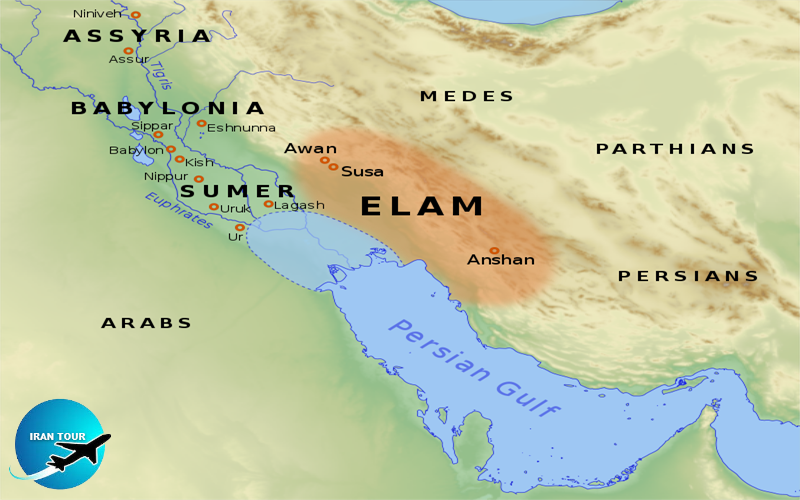 |
| Elam - Haltamti - ????? |
At the time of its Greatest power, the border of Elam extended from Mesopotamia to the Indus valley and from central IRAN to the Persian Gulf. The question of the country of origin of the Elamite people has aroused much discussion. Although they called their country ‘ Haltmati ‘ or ‘ Altamti ‘, meaning land of gods, from ‘ hal ‘ or country and ‘ Tatnti ‘ or gods, Assyrian and Babylonian records contain the name Elam’ which means high or mountainous region. The old Persians used the term 'Uja’ or 'Huja', also meaning mountainous people. This might indicate that, although the alluvial plain of Khuzistan was the center and core of the Elamite kingdom, the original homeland of the Elamites lies in the highlands bordering the plain. Ancient historians also record the name of 'Uxii*, a trace of which remains in the modern name of Khuzistan.
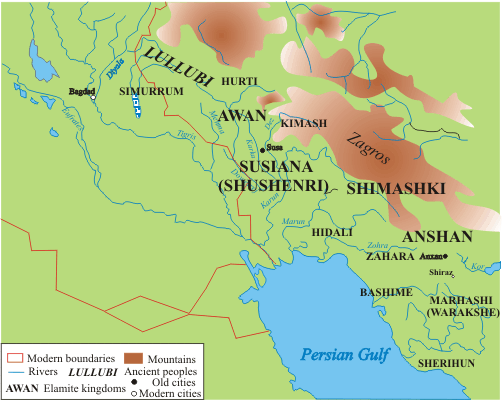 |
| Polities during the Old Elamite period, and northern tribes of the Lullubi, Simurrum, and Hurti. |
Despite this, the excavation at Abu-Fandowa illustrates the situation found in sites all over Khuzestan; that is, there is a continuous development from the prehistoric to protoliterate to Elamite periods, with no abrupt changes to indicate the appearance of a new people, considering the extent of development by the prehistoric people of Khuzestan, particularly illustrated at Susa which, by the end of the fifth millennium B.C., had entered the phase of urbanization, with a highly developed commercial, economic and political organization, it seems most likely that the Elamites, notwithstanding the etymology of their ancient names, were the direct descendants of the earlier people who inhabited the alluvial plain and produced the prehistoric buffware culture.
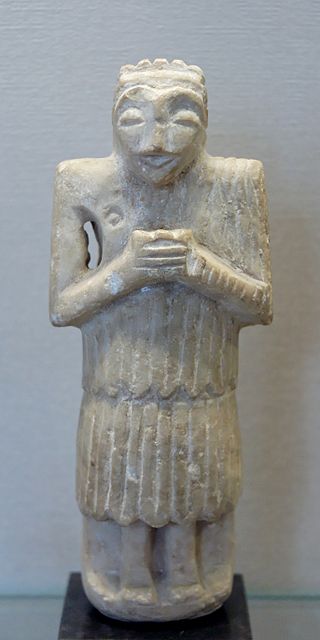 |
| Orant figure, Susa IV, 2700–2340 BC. |
The main parts of the Elamite kingdom were Awan, located northwest of Susa and occupying the region between the Dez and Karkheh rivers Simash, occupying the northern and northeastern part of the alluvial plain and including most of the highlands dominating the plain; Anzan, occupying the eastern and southeastern part of the plain and including the area of Malamir Bakhtiari, extending to Fars; as a whole including the alluvial plain and the surrounding highlands.
The plain of Khuzestan is continuous with the Mesopotamian plains and the kingdom of Elam developed side by side with its Sumerian counterpart there. A constant state of political conflict continued throughout the long history of these neighboring countries, often breaking out into actual warfare. One of the earliest Documentary references to the Elamites occurs in a Sumerian text of about 2700 B. C, which records a victory of summer over Elam. The Sumerians and Akkadians made repeated military forays into the mountainous fringe of Elam to obtain such important natural materials as timber, lead, copper, silver, stones including marble, diorite semi-precious gems, and obsidian, as well as highbred horses. The Elamites in turn invaded the plain of Mesopotamia to gain control of the area and to collect rich booty from its well-developed cities and towns. An example of the valuable relics brought back by the Elamite kings is the code of Hammurabi, uncovered at Susa by the french and now in the Louvre Museum.
Concurrent with this constant political conflict, tremendous cross-cultural exchanges between these two powers contributed so much to the early development of human civilization. Writing was, if not first invented in Iran, developed simultaneously in Elam and Sumer. Although the Elamite language, which was Japhetic one of the ancient languages of western Iran, was quite different from Sumerian, some signs, logograms, and ideograms are shared in both languages.
The religion of the Elamites was polytheistic, with the primary position given to Inshushinak " the lord of Susa" to whom many temples and ziggurats, including the great ziggurat of Choga Zanbil, were dedicated. Also of great importance was the mother goddess, Ishtar, and many broken clay statuettes of her have been found at.
Half Tepe
Politically the known history of Elam is fairly continuous, with the Exception of several gaps, one of which is now beginning to be filled by the excavation of Haft Tepe. The earliest known dynasty, the dynasty of Awan, began around 2700 B.C. The first three kings of this dynasty are not known, but the fourth king was peli who ascended the throne around 2600 B.C. Twelve kings of this dynasty ruled from 2670 to 2200 B.C. in Awan and its vicinity. After 2200 B.C. a dark period occurs, covering two centuries, caused apparently by the activities of the people of Guti in Iran and Mesopotamia, which disturbed the development of local rulers. From 2100 to 1850 B.C., for almost three hundred years, the dynasty of smash, with eight to ten kings, ruled in the region of Simash and its immediate outlying areas.
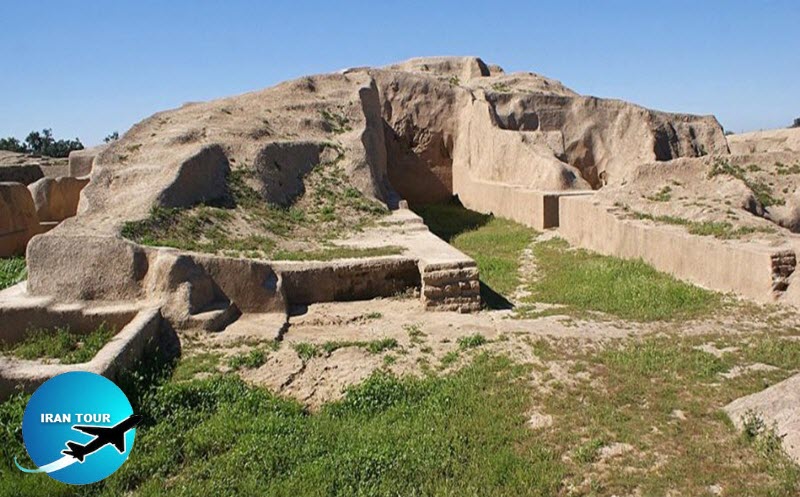 |
In 1830 B.C. the dynasty of Elam appeared, and under it the great Elamite kingdom took form and expanded, gaining control of a vast region and becoming a considerable force in the ancient world. At the height of its power, Elam included Awan, simash, parsumash, and Anshan as well as the main alluvial plain, and had the greater part of the Iranian plateau under its control, part of southern Mesopotamia, and almost the whole region of the northern shores of the Persian Gulf, extending possibly to Baluchistan.
With the growth of Elamite territory and the development of their political, commercial, and cultural life, an organized system of administration was developed. Elamite documents record three major figures in the government first was the 'sukulma' or king, the highest ruling position. The ‘ Sukulma' selected from his close relatives the persons who would rule the city of Susa and the other parts of the country, the most important of these were the ‘ Suka-Elam’ the ruler of the whole area of Elam, and the ‘ Sukai-shush’, the governor of the great city of Susa, who would eventually become the next king or 'sukuma'.
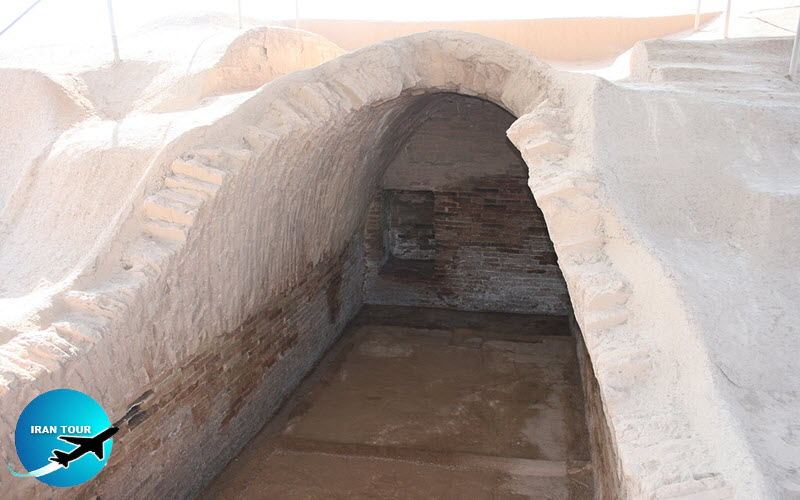 |
| Royal tomb of Haft Tepe |
Following this system of administration, various dynasties ruled in Elam in turn, the Ebarti family, founded by Ebart or Ebert, ruled for over three centuries between 1830 and 1505 B.C. After a gap of almost one hundred and fifty years came the reign of the Igehalkfamily, kings of Anzan or Anshan, founded by Igehalki who took over the throne about 1350 B.C. their rule continued until 1210 B.C. Between 1205 and 1110 B.C. the Shutruki family reigned. After another long gap came the emergence of Neo-Elam whose kings ruled from 760 to 640 B.C. when Elam was submerged in the Medean and then the Achaemenian empires.
Susa became one of the great capitals of the Achaemenian Empire and Elam one of its most important provinces or satraps, the highly developed administrative system of the Elamites was utilized by the Achaemeneans. Continued to employ the Elamite language as one of their three major languages, used for Proclamations of the empire.
SUSA
Susa in the Susiana region of southwestern Iran prospered as the cultural center of the area already in the prehistoric age. This is also the birthplace of the ancient kingdom of ELAM. Around 3000 B.C., in parallel with the JEMDET-NASR period in Mesopotamia their own letters known as "Proto-Elamite script" appeared there and the cylinder seal took the place of the stamp type seal. The area which geographically has the closest link with Mesopotamia among Iranian regions saw particularly remarkable progress in civilization. Susa where the almost earliest urban civilization in Iranian regions was established became the capital of ELAM which governed the extensive range of hights and plains from the Persian Gulf to the Bushehr district and came to be frequently referred to in the stories of conflicts of the Elamites with Babylonia and Assyria.
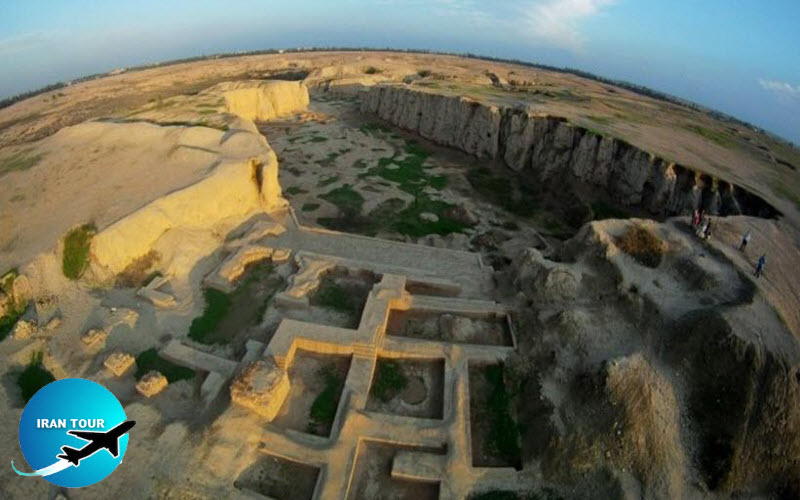 |
| The ancient city of Susa in Iran is a worldwide treasure |
The Elam which fled the political control of the Kassites in the thirteenth century B.C. reached its culmination in the reign of Shutruk Nakhunte (reigned 1207–1171).
This king founded shrines in the principal cities in his kingdom. and, at the same time, he attacked Babylonia and defeated the last king of the dynasty of Kassites. As a result, he enthroned his son Kutir-Nakhunte as the king of Babylon. Eight hundred towns were destroyed by this large-scale intrusion and the statue of Manishtusu (Accadian dynasty) in Eshnunna, the triumphal monument of Naram-sin, and the stone column inscribed with Hammurabi's Code of laws in SIPPAR and the obelisk of Manishtusu in kish was plundered by him. He brought them to SUSA and donated them to the shrine of INSHUSHINAK. Later, Susa was chosen as the capital by CYRUS, the founder of the ACHAEMENLAN dynasty, and the capital was built by DARIUS 1.
Darius not only erected the palace but promoted the consolidation of the trunk Road connecting the principal cities in West Asia. It is called the "ROYAL ROAD". The Royal road starting from Susa Crosses the TIGRIS river at the foot of Mt. ARBELA, passes the cities of HARRAN, and aches EPHESOS, with its total length of 2683 Kilometers. One hundred and eleven stations were Prepared along the road and they were provided with horses. Imperial messengers galloped changing horses. A part of the stone pavement of another important road connecting Susa and PERSEPOLIS still remains today, this road runs through "FAHLLAN" and the Gate of PERSIA.
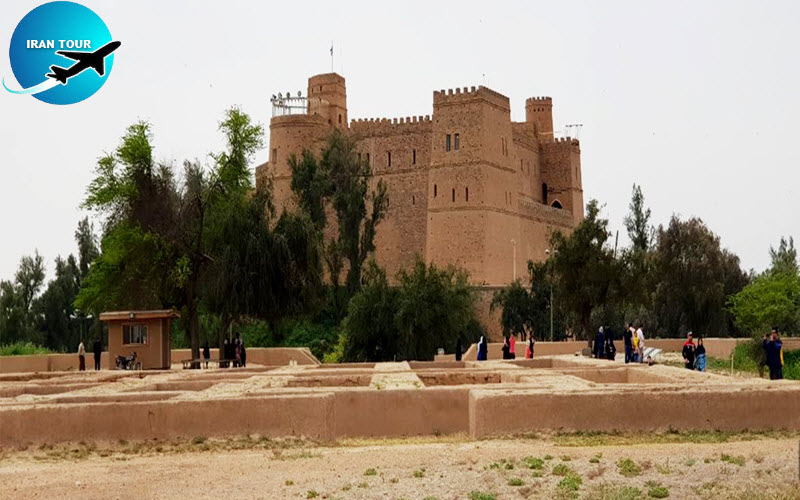 |
| Palace of Darius in Susa(Apadana Palace) and a view of French Castle |
Another trunk road was the road from SUSA through Luristan to ECBATANA (present Hamadan). The famous Persian wars started by the military expedition of Darius to Greece were caused by the rebellions in Ionian colonies in Asia Minor. The most resistant were the people of Miletos. The bronze offering with the Archaic-Ionian inscription found at Susa is also a part of the sacked objects. At this time, the people of Miletos were taken to Susa as captives and reportedly were settled at the mouth of the Tigris later.
Alexander's military expedition to the eastern lands which ended the Achaemenian Dynasty took place in the fourth century B.C. The Macedonian army led by him first swept Mesopotamia and occupied Babylon then Susa was conquered without storing resistance. the family of Darius was Kept in Susa, and the citadel of Susa was built by Darius, and the enormous amounts of treasures in the palace was under the control of Macedonians. Thus Susa became the base of Alexander's maneuvers.
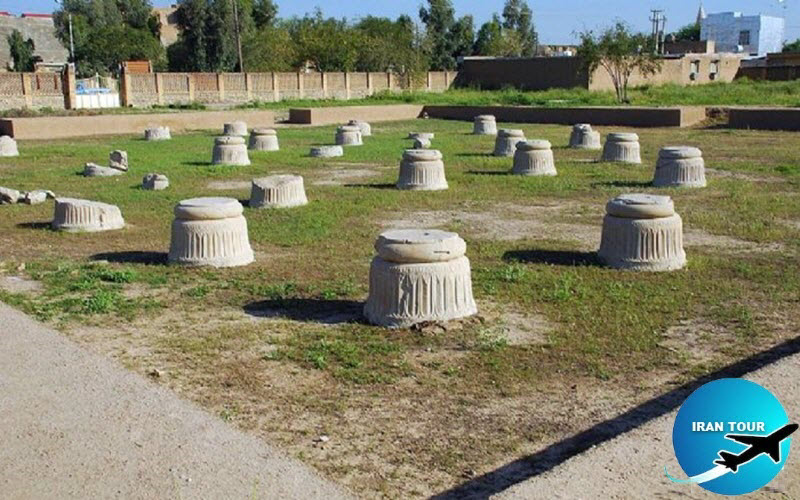 |
| The Shahoor's Palace (Ardeshir II Palace) 2020 Tourist Attraction in Susa |
"Acropolis" B. C. 5τh century, SUSA
Susa was the capital of Elam referred to in the old Testament. There are several deserted hills called "Tepe" in Iranian. On the central one of the hills, which is known as "ACROPOLIS", there were the palaces and shrines of the Achaemenian dynasty. The rows of foundation stones seen there are of the small palace built by Artaxerxes II. Darius who had lived in Babylon moved his capital to Susa around 521 B.C. before that, Susa, the capital of Elam, had been plundered by Assur-bani-pal and the "Acropolis" with its Elamite palaces and shrines had been ruined. Darius here constructed a solid citadel and erected his palace and shrine on a hill nearby, and he placed the city itself near them across a road. All of these three sections were enclosed by a wall and a moat outside the wall, into which was diverted the flow of the "Chahur River". Darius left a record concerning the construction of his palace, which contains the following words. "The wood called Naucaina (cedar) was brought from a mountain called Lebanon."
The people of Assyria brought it up to Babylonia; The people of Karka and Ionia brought it from Babylonia to the land of Susiana. the wood called (Yaka) was brought from Gandhara and ... Karmana. Gold which was employed here was brought from Sardis... and Bactria... that which was employed here of silver and of copper (and) bronze was brought from Egypt ... the column of stone which was employed here was brought from a town called Aphrodisias of Georgia. Those who worked in gold were the Medes and Egyptians.
The site of Susa was excavated by a french scholar M.A. Dieulafoy and his wife as early as 1884. But a more Scientific excavation survey was undertaken by a party with De Morgan as its head in 1897 and it revealed the culture of Susa in the prehistoric agricultural society before the Elamite period. According to the results of the investigations, Susa had been a leading cultural core of Susiana from very old times. And it later became a center of the civilization of the Iranian plateau.
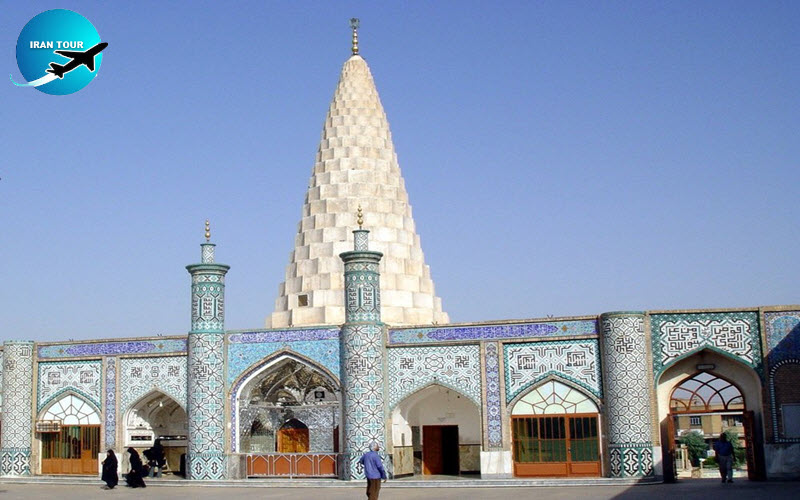 |
DANIEl'S TOMB
Another Biblical association with Susa is The Tomb of Daniel, the conical white sugar loaf shrine just across the road from the archaeological site, standing on the east bank of the River Shaur, it attracts Muslim Pilgrims who for centuries have regarded the prophet’s remains as having miraculous Powers, Particularly in preventing drought. At one time, by order of the caliph Omar, the coffin is said to have been buried under the bed of the Shaur whose waters were diverted for this purpose, in order to prevent disputes as to who should possess the precious relics. When the Arabs first reached Susa in the Seventh century, they found Daniel’s coffin in the great citadel. In The Twelfth-century A.D. the Seljuq sultan Sanjar is said to have decreed that the coffin be encased in an outer shell of crystal and suspended by iron chains from the middle of a bridge spanning the river. The mausoleum is believed to have been on the same site at least since the Twelfth Century but has obviously been rebuilt many times. Visitors are welcomed but women wishing to enter the shrine must have to wear a chador. (Ankle-length veil).
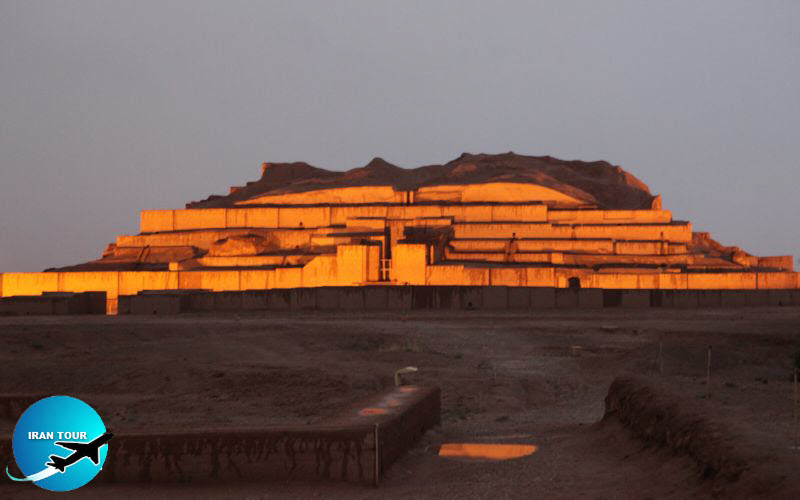 |
СHOGA ZANBIL
The great Elamite Ziggurat of Chogazanbil, is about 30 km. from Haft Tape, standing among low Hills on the right bank of the River Ab-idez, a tributary of the KAROON. (Choga is a local word meaning hill, while Zanbil means a large basket, which the unexcavated mound resembled ). Built by Untash Gal, king of Elam about 1250 B.C., the massive artificial mountain was the focal point of his city of Dur Untashi, and was dedicated to the Great God Inshushinak, "Lord of Susa", symbolized by the form of a bull. Although now much denuded compared with its original height, the Ziggurat remains the Largest man-made structure in Iran and is perhaps better preserved than any comparable Monument to be found in Mesopotamia.
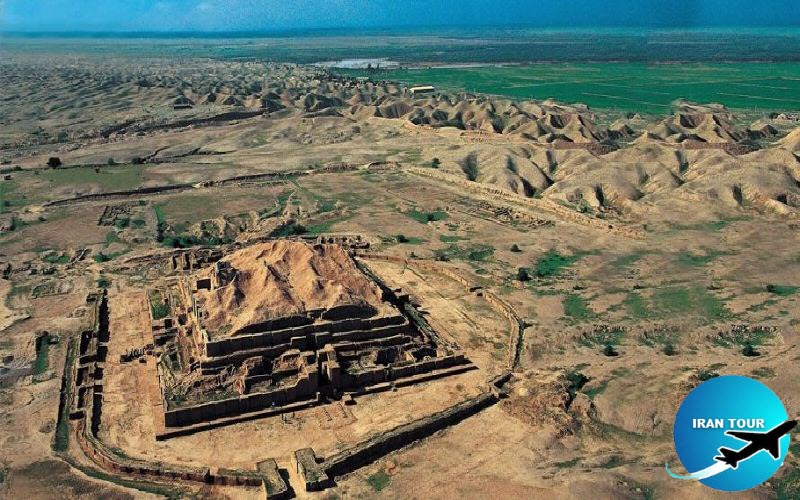 |
Choga Zanbil was both a temple and a tomb and was built in the form of five boxes of increasing height, placed one inside the other. The tallest, innermost tower was 28m. square at its base and nearly 50m high, with four monumental, vaulted brick doorways each over 7m high, leading into complex tombs, tunnels, and chambers, some of which are over 15m. long, on the flat top was a temple where the "GOD INSHUSHINAK" was believed to ascend every night, and from thence to heaven.
Along with much else at the site, the temples at the base of the "ZIGGURAT" were pillaged by the Assyrian, Ashurbanipal, when he overthrew the Neo- Elamite- and also destroyed SUSA-(Round 640 B. C).
CHOGAZANBIL(The first Iranian monument recorded as a world heritage site in 1979) consists not only of the ZIGGURAT but of a large complex within an outer wall 1200 × 800m constructed, around a sacred enclosure some 400m. square and pierced by seven gates. Inside this enclosure were three temples and several paved courtyards with sanctuaries, as well as store Houses containing weapons and ornaments.
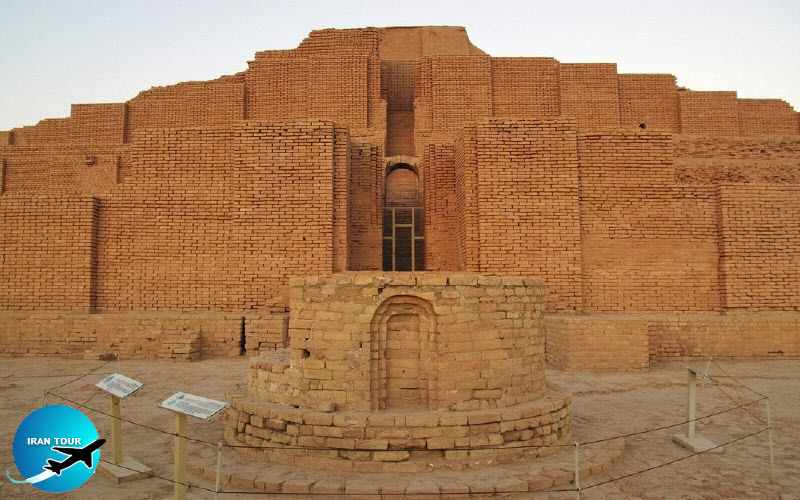 |
The ZIGGURAT, with an outer base of 10 m. square is built mainly of sun-dried brick bonded with cement and bitumen and was faced with glazed kiln-fired bricks of blue and green with a metallic shimmer, similar to those found at SUSA. Glazed terracotta emphasized architectural details; wooden doors were decorated with opaque glass mosaics depicting prancing animals, and inlaid ivory mosaics were also used in the lavish decoration of this splendid structure which was discovered in 1935, by prospecting Geologists of the then Anglo-Iranian oil company.
In 1936-9, the French Archaeological Mission, headed by R. de Mequenem, worked at the site which was identified through the cuneiform inscriptions on many of the bricks found in Situ, most of them repeating the name of "UNTASHGAL". Professor Ghirshman resumed the enormous task of revealing this site in 1946 and continued until 1962. (The ZIGGURAT which today has only three of its original five stories). There is a steep staircase on the northwest side up which one can climb to the summit for a good view of the entire site.
Two temples dedicated to INSHUSHINAK, and probably used only during daylight hours, were found in the center of the second story on the southeast side, among many other chambres built into each side of the wide terraces. Three ramps leading up the first, quite low storey was found on the northeast side, one at right angles and the other two on either side, laterally. Near these ramps, in the outer court, two bases were found on which two-winged guardian genii, lying nearby, probably stood. on the north-west side of the ZIGGURAT, opposite the approach staircase, stands a circular brick-built platform believed to have been an altar for animal sacrifices like the rest of the monument, this has been restored, but you can see some excellent examples of the cuneiform inscribed dedicatory bricks here, in the earliest known type of the triple-arched niche. This was probably attached to the temple of the "Ishniqarab" which was adjacent, with, next to it, the sanctuaries of "KIRIRISHA" the mother-Goddess, and the God "HUBAN". some of these chambers are below the present level of the courtyards, around which were the kitchens and stores, and living quarters of the priests.
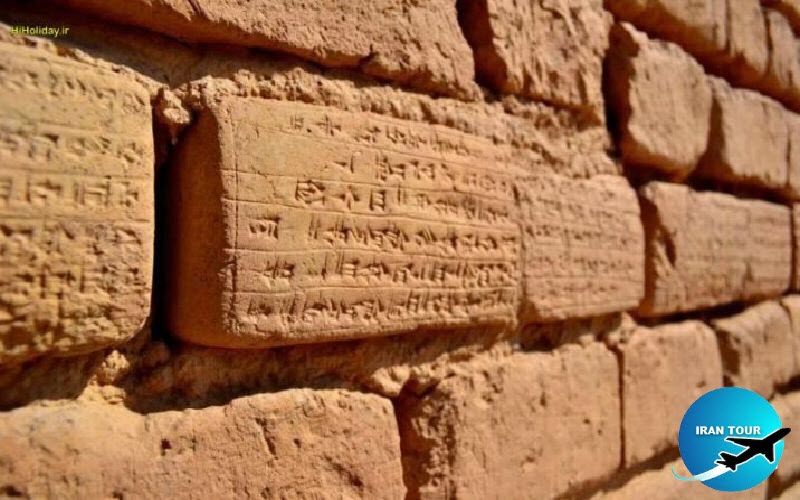 |
A gateway flanked by towers was found in the middle of the northeast wall surrounding the sacred enclosure, and another in the southeast wall has been called "the Royal Gate" because of its impressive size and elaborate decoration. In the angle formed by these two walls, the remains of four other temples were found, built side by side. More than 100 cylinder seals were found in chapel buildings opposite the south-west facade, many of them made of deep blue glass possibly showing an Egyptian influence, one of the most interesting finds, which can be seen in the Tehran Museum, is that of a humped bull or Zebu, which was carefully restored by Madame Ghirshman, and which originally stood as a guardian before one of the gateways.
Across the back of the creature is a dedication in cuneiform to the God INSHUSHINAK. About 300m. from the Royal Gateway, walking towards the approach, eastwards, are the remains of one of three palaces, this one containing five underground, vaulted tombs. The charred remains of two cremated skeletons were found inside each of four tombs discovered intact, with one uncremated skeleton lying on a platform beside two of the cremated bones. "ELAMITES" were normally buried, indicating a change of custom for Royalty, and it has been suggested that the queens s followed their husbands to the funeral pyre, but no proof has so far been found that these were Royal Corpses. The second palace is some 50m. northeast, seemingly reserved for Royal Ladies, to judge from the many small rooms around the two courtyards; the third palace nearby consists of two courtyards each with four suites of rooms. All three palaces are different in style from those found in "MESOPOTAMIA", being much simpler in the plan. on the northwest side of the "ZIGGURAT" outside the city walls, one can see traces of the elaborate system of Irrigation that served the city, including reservoirs made of burnt brick and bitumen.
 |
НАFT TAPE: (means sevем моunds)
From Ahwaz, one can take the popular minibus service to SUSA, but one needs independent Transport to see all the sites in the area. Hafttape. the fascinating Elamite site dating From the mid-second millennium B.C. which professor E. Negahban, of the University of Tehran, has been excavating since 1965. The name Hafttape means "seven mounds", although in fact the site covers more than a dozen mounds, and is a vast architectural complex that includes royal graves and at least one Temple. During the first season, a late fourth and early third millennium B.C. wall was uncovered, together with rough, coarse pottery that possibly dates from the sixth millennium. Painted ware contemporary with Jaffarabad, a site near Susa, was followed by ware similar to that of the lowest sea levels, and this again by proto-literate Elamite and finally, characteristic Elamite Pottery of the second millennium B.C.
The discovery of The Hafttape site has filled one of the less well-documented periods in Elamite History, between c. 1500 B.C. and 1300 B.C. - Just before The most illustrious Period of the Elamite Empire, The thirteenth century B.C which saw the construction of the impressive ziggurat of Choga Zanbil. Here you will see two tombs with vaulted roofs, the larger, eastern chamber, 10.30 × 3.25 m. in size and Known as the Royal Tomb, contained, twenty-one skeletons. A platform 60 cm. high covers four-fifths of the floor, with a channel running down one side, leaving an empty space at the rear.
The platform was divided into three sections by low narrow walls pierced with holes to allow drainage into the channel. Seven skeletons were lying side by side, all packed in ritual red ochre, with a few funerary objects in the first section. The smallest, and middle section was empty, but at the back were two incomplete skeletons. A doorway behind the platform led up a flight of stairs into the temple behind. which can be seen after climbing the ramp to the top of the mound. Near this doorway twelve roughly heaped, incomplete skeletons were found. This is a particularly important tomb because it still remains one of the earliest known vaults, dated about 1500 B.C., that is, some 250-300 years older than similar arches at Choga Zanbil. (Early morning Light is best for photographing this tomb).
 |
The second, smaller tomb lies parallel to and a little to the west of the Royal tomb, walk up the ramp by the side of the latter, turn right and you can look down on the open grave whose roof has disappeared but which has been given a temporary protective covering. The work on this enormous site has been extended to the east where a large number of impressive buildings and courtyards, probably of palace structures, with walls coated with painted plaster, have been discovered, An astonishingly massive wall, 12 m. wide at the top, was revealed here, with some 500 inscribed clay tablets which on a preliminary study appear to mainly account treaties and commercial agreements.
It is Now believed, following the translation of an incomplete Neo – Babylonian inscription of Tepti–Ahar, which was found in the temple courtyard, that this was a religious center of the period of king Tepti-Ahar who built the royal tomb and the temple for one of his wives. other finds have included a bronze plaque possibly part of a doorframe showing a warrior-king standing on a lion and holding a bow, with a quiver at his back. Behind him. stands a priest while a nude woman kneels before him. The workmanship is characteristic of the mid-second millennium and has been compared with a figurine of the fertility goddess Ishtar found some years ago on the same site.
- Details
- Category: IRAN Blog